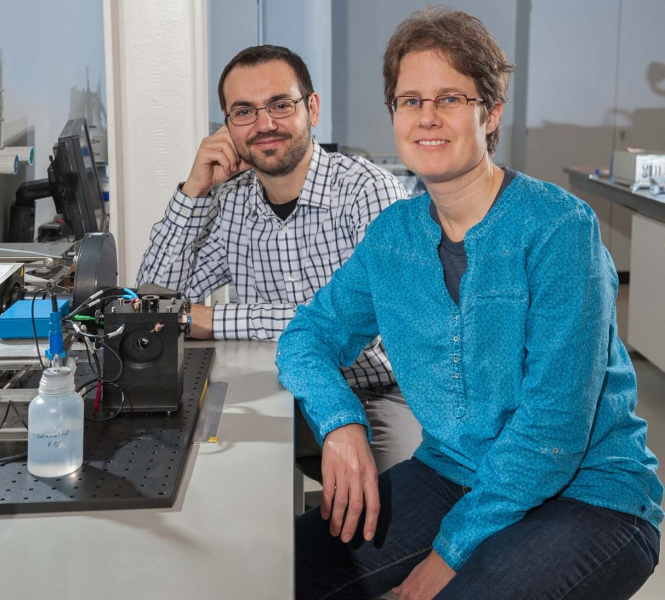Most of the worldwide research efforts in solar fuels are directed at the splitting of water into hydrogen and oxygen. However, no efficient catalytic or traditional chemical alternative catalyst is yet available. Tenure trackers Anja Bieberle and Mihalis Tsampas each explore an artificial leaf approach to DIFFER’s solar fuels theme. In their five year programs, they are working on direct conversion of solar energy into chemical bonds.
 Mihalis Tsampas (left) investigates photo-electrochemical promotion of solar fuel conversion in solid electrolytes. Anja Bieberle (right) studies interfaces in photo-electrochemical systems to uncover the limiting features in today’s photoelectrodes.
Mihalis Tsampas (left) investigates photo-electrochemical promotion of solar fuel conversion in solid electrolytes. Anja Bieberle (right) studies interfaces in photo-electrochemical systems to uncover the limiting features in today’s photoelectrodes.
Bieberle: Take a walk outside: sunshine, wind - all that energy is available, and we are not using it. Yet! When you get electricity from a solar cell, you either need to use it immediately or you have to store it in a battery. Direct conversion of sunlight into a storable fuel would be much better, right?
Tsampas: The goal with solar fuels is to offer an alternative to fossil fuels. Fundamental research is essential to develop these sustainable technologies. Both our approaches are electrochemical in nature: we directly use sunlight in a device to convert water and CO2 into hydrogen or hydrocarbons.
Bieberle: In my group, we want to design better photoelectrodes for photoconversion. To reach that goal we investigate the interface where solid electrode meets liquid electrolyte in solar fuel devices. By combining experiments with modeling and simulations, we can investigate the fundamental processes and limitations at the interface.
Tsampas: Together with my group, I want to use electrocatalysis to enhance an artificial leaf-type cell. We will develop novel materials and methods for solar fuels production in solid photoelectrochemical cells. The main idea is to use electrochemistry to tune the selectivity of a reaction towards a desired product, i.e. specific fuel.
Bieberle: This is one of the things that I like at DIFFER: working together with people from diverse disciplines. I am collaborating with different researchers from the fusion group on nanostructuring surfaces with plasma and on modelling and simulation of interfaces. Although our fields are different, the shared focus on energy makes it easy to connect.
Tsampas: In our groups and in energy research in general, we draw on many different disciplines to realize a breakthrough: chemistry, materials science, engineering, physics... I think that over the next years, when we’re all in the same building, the current research groups will find more and more synergy and inspire each other to even more innovative approaches.
 Mihalis Tsampas (left) investigates photo-electrochemical promotion of solar fuel conversion in solid electrolytes. Anja Bieberle (right) studies interfaces in photo-electrochemical systems to uncover the limiting features in today’s photoelectrodes.
Mihalis Tsampas (left) investigates photo-electrochemical promotion of solar fuel conversion in solid electrolytes. Anja Bieberle (right) studies interfaces in photo-electrochemical systems to uncover the limiting features in today’s photoelectrodes.Bieberle: Take a walk outside: sunshine, wind - all that energy is available, and we are not using it. Yet! When you get electricity from a solar cell, you either need to use it immediately or you have to store it in a battery. Direct conversion of sunlight into a storable fuel would be much better, right?
Tsampas: The goal with solar fuels is to offer an alternative to fossil fuels. Fundamental research is essential to develop these sustainable technologies. Both our approaches are electrochemical in nature: we directly use sunlight in a device to convert water and CO2 into hydrogen or hydrocarbons.
Bieberle: In my group, we want to design better photoelectrodes for photoconversion. To reach that goal we investigate the interface where solid electrode meets liquid electrolyte in solar fuel devices. By combining experiments with modeling and simulations, we can investigate the fundamental processes and limitations at the interface.
Tsampas: Together with my group, I want to use electrocatalysis to enhance an artificial leaf-type cell. We will develop novel materials and methods for solar fuels production in solid photoelectrochemical cells. The main idea is to use electrochemistry to tune the selectivity of a reaction towards a desired product, i.e. specific fuel.
Bieberle: This is one of the things that I like at DIFFER: working together with people from diverse disciplines. I am collaborating with different researchers from the fusion group on nanostructuring surfaces with plasma and on modelling and simulation of interfaces. Although our fields are different, the shared focus on energy makes it easy to connect.
Tsampas: In our groups and in energy research in general, we draw on many different disciplines to realize a breakthrough: chemistry, materials science, engineering, physics... I think that over the next years, when we’re all in the same building, the current research groups will find more and more synergy and inspire each other to even more innovative approaches.
Go to the News page.